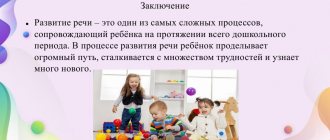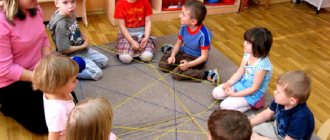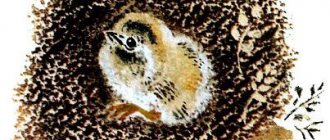In the modern world, where a child’s book is replaced by a computer, the Internet and other means of technological progress, the issue of speech development in preschool children is especially acute.
Listening to adults, children remember many words, expressions, the way they are used, and in this way enrich their language. One of the tasks of reading and storytelling is to enrich the child’s vocabulary.
Psychologists say that preschool age is a sensitive period, which is the most favorable for the development of speech, as well as the formation of a child’s verbal communication culture.
Scientists such as L.S. Vygotsky, A.S. Leontiev, E.I. studied the problems of speech development in preschool children. Tikheyeva, O. I. Solovyova.
E.I. Tikheyeva, who is the founder of the method of speech development, believed that mastering all types and manifestations of speech means mastering the instrument of human mental development.
A.M. made a great contribution to the development of the problem of speech development. Leushin, who proposed to reveal the strong positive aspects of children's speech, to understand for oneself all the wealth of its potential possibilities in order, based on them, to develop what is already present in children's speech.
Practice shows that the development of speech in preschool children is a very labor-intensive and responsible process that requires a certain system and patience on the part of the teacher, selection of the most effective teaching methods and techniques. And given that the child spends almost the whole day in a preschool organization, the main responsible person is the teacher.
One of the effective means of speech development is a fairy tale, an absolutely necessary stage in the development of a child’s speech. The fairy-tale and folklore world is a system that is most optimal for the perception of understanding by a child - a preschooler, which fully corresponds to the age characteristics and needs of the child.
Based on our experience of working in kindergarten, we found out through questionnaires and individual interviews with parents that in the family adults do not read fairy tales to children, but go about their business, while children are distracted by TV or playing on a tablet or cell phone. Spending most of their free time with gadgets, children become saturated with unnecessary information, which makes them hyperactive, restless, unable to negotiate with each other, and communicate little. And the lack of verbal communication with peers and adults leads to the fact that children speak poorly and have a minimally meager vocabulary.
The adult generation understands the enormous importance of speech, which helps a small preschooler to explore the world around him, share his knowledge, and talk about his experiences. A small person who has a meager vocabulary in his active vocabulary is deprived of such an opportunity. As speech develops, the child's thinking processes develop. The inclusion of fairy tales in all types of activities when working with children in kindergarten and the use of traditional and non-traditional methods and techniques significantly influence the comprehensive development of a preschool child.
The development of a child, teaching him with the help of a fairy tale, is emancipation, this is the development of speech. Agree that when a child sits with his arms crossed, this is not very good. And when we force you to just listen, then there is no activity. He listened, but that doesn’t mean he heard. And when he plays a fairy tale, then you can be sure that from this fairy tale he will take something for himself, begin to understand the world around him, live in harmony with it, convey his mood with the help of emotions, gestures, and facial expressions. As teachers, I am faced with the task of building work with families to study fairy tales based on a dialogue of mutual trust and understanding. All this contributes to the development of the child’s personality and is the most important condition for successful work on the development of children’s speech. A fairy tale is an amazing phenomenon of folk art. Simple and uncomplicated in appearance, it is interesting for both small children and adults. A child enters the world of fairy tales in very early childhood, as soon as he begins to speak. Once woven to a child, a fairy tale remains with him forever as a miracle, as joy, as a memory. Currently, it is difficult to find a better way to raise children than by introducing them to oral folk art from early childhood. The fairy tale gives moral lessons of compassion, selflessness, empathy, love for all living things, an idea of morality, justice, the need to fight evil, and expands the child’s life experience. Russian folk tales develop figurative thinking and expressiveness of speech, as they are rich in lyrical inserts, vivid character characteristics, rhythmic melodiousness, and dialogues. The fairy tale fosters love for the Motherland, introduces one to the native nature, customs, and way of Russian life. Listening to fairy tales, the child learns the sounds of his native speech and its melody. The older the child becomes, the more he feels the beauty and accuracy of the original Russian speech, is imbued with its poetry, the little person not only comprehends the Russian language, but also gradually becomes familiar with folk wisdom. A fairy tale contains the wisdom of the people, it teaches children to empathize, distinguish between good and evil, helping a friend expands the child’s life experience, preparing him for future independent life in society.
The word “fairy tale” itself means something that is told. The largest researcher and collector of fairy tales, A. I. Nikiforov, gave the following definition: “Fairy tales are oral stories that exist among the people for the purpose of entertainment, containing events that are unusual in the everyday sense and are distinguished by a special compositional and stylistic structure.”
“Fairy tales are brilliant, the best gold in the world, the gold that sparkles in children’s eyes, rings with laughter from children’s lips and the lips of their parents.” Of course, any educational process takes place together with parents, who take an active part in the development of the speech of their beloved child. In this regard, we would recommend that they:
-reading folk tales with changing voice and intonation;
-joint board games based on fairy tales;
-joint production of little books to enrich the group’s library;
-days without a gadget (turning off TVs, phones and computers for the whole day);
- staging and dramatization of a fairy tale by parents together with their children.
The development of speech in classes using fairy tales provides a comprehensive impact on the child’s speech sphere and helps the child enrich his active vocabulary. “Fairy tales can help educate the mind, give keys to enter reality in new ways, can help a child learn about the world and gift his imagination,” said the great teacher D. Rodari. By retelling and telling fairy tales, children develop grammatically correct speech, rich in complex sentences, with a variety of vocabulary: verbs that determine action; adjectives characterizing characters; adverbs. This promotes comprehension of the expressive details of the text, the merging of figurative and logical components.
Modern methods of speech development include various techniques for improving all aspects of the speech culture of preschool children.
There is also a well-known classification of fairy tales according to their content: Fairy tales. They reveal the best human qualities, the heroes are romantic. In such a fairy tale there is always a central positive hero, his assistants and magical objects. Heroes of fairy tales fight evil and injustice in the name of goodness and love. Examples include Russian folk tales about Ivan the Fool. Tales about animals. Here the main characters are animals (fox, wolf, bear, hare, etc.). Animals interact, each of them personifies one or another human quality, for example, a cat is smart, a fox is cunning, a bear is strong. Examples: “Teremok”, “Turnip”, “Kolobok”. Social fairy tales illustrate real life, the characters are shown from the point of view of their social status, and negative human qualities are ridiculed. The best qualities in such fairy tales are possessed by people from the people, who, as a rule, turn out to be smarter and more cunning than representatives of high social status (lords, priests). These tales are satirical and contain a lot of humor and puns. Examples of social fairy tales: “Porridge from an Axe,” “The Master and the Carpenter,” “The Peasant and the Priest.”
It is extremely important to create favorable conditions for the development of speech in accordance with the age characteristics of the child. The professional use of various pedagogical means, techniques and methods and their skillful combination can not only develop children’s speech, but also ensure harmonious education in accordance with modern requirements.
Modern methods of speech development contain a variety of techniques for improving all aspects of preschoolers’ speech. They can be used when introducing children to fairy tales. Let's look at some of them:
Reading aloud and telling fairy tales - they play a dominant role in introducing children to fairy tales in all age groups.
Modeling fairy tales. The use of geometric shapes, schematic images, as stimulus material for composing the plots of fairy tales.
For example,
fairy tale "The Three Little Pigs" -
"The wolf and the seven Young goats" -
The use of mnemonics for preschool children is becoming relevant, since diagrams and mnemonic tables greatly facilitate the process of mastering the literacy of structured speech for children, in addition, the presence of a visual plan + diagram makes fairy tales clear, coherent and consistent.
Rhythmization (tapping, clapping rhythm, reflecting the characteristics of the movement - fast, drizzling rain, the mood of the characters - “a sad little bear is walking”, “a cheerful bunny is jumping”)
Psycho-gymnastics - expressive conveyance in facial expressions and movements of emotional states (sketches “Grief”, “Joy”)
Musical accompaniment (fragments of classical works: A.I. Khachaturian “Sabre Dance”, P.I. Tchaikovsky “Waltz of the Flowers”)
Fairytale therapy is an integrated activity in which actions in an imaginary situation are associated with real communication aimed at activity, independence, creativity, and the child’s regulation of his own emotional states.
Verbal director's game - children's exercise in the sound design of a coherent statement (different strength of voice, tempo and rhythm of speech), the use of figurative expressions, fairy tale repetitions, as well as lexical means (adjectives, adverbs) in speech to determine their emotions, feelings from listening to a fairy tale , music.
Verbal drawing is the exact definition in words of the characters’ states (“the cockerel was offended”), the depiction of their poses, facial expressions, and gestures that are not disclosed in the context of a literary work (the eyes of the mice are joyful, they smile, dance).
Dramatization is “a game of children in a story that has been told or read” R. I. Zhukovskaya
I would like to end the article with the words of Shalva Amanashvili: “Children need fairy tales like air, because through fairy tales - smart, wise with incredible and ordinary events, fantastic and ordinary heroes - they comprehend the truth of life. Fairy tales crystallize the soul of a child and purify the soul of an adult.”
In our kindergarten, fruitful work is being done to develop the speech of preschool children. All teachers use in their work reading and dramatization of various fairy tales and many other forms and methods that contribute to the comprehensive development of children.
Bibliography
- Deryagina L.B. Theatrical activities in preschool educational institutions., Childhood-Press, 2014.
- Russian folk tales edited by Volkova T.S. , Labyrinth, 2015
- Anikin V.P. Russian folk tale. - M., 1977
- Bunyatova A.R. The role of fairy tales in the formation of spiritual and moral values in preschool children. // Advances in modern natural science. - 2010. - No. 6
- Zimina I.N. Folk tale in the system of education of preschool children. //Preschool education//.- 2005.- No. 5.
- Zinkevich-Evstigneeva, T. D. Fundamentals of fairy tale therapy. — M.: Rech, 2006
- Nikolaeva N. D. Possibilities of the magical world of fairy tales in teaching and education. // Ethnopedagogy in the context of modernization of Russian education. — Yakutsk, 2004
- Koltsova I. N. Sociocultural functions of fairy tales. - N. Novgorod, 2000
- Strelkova L.P. Fairy tale lessons. - M.: Pedagogy, 1989.
- Pasternak N. A child needs fairy tales like air // Preschool education //.- No. 8-2008. -23-35s.
Literature
- A system of classes based on Russian folk tales for children of different ages is recommended in the book by O.B. Sizova “Six Steps to Speech Development.”
- Lessons based on fairy tales for children 6-7 years old were developed in the book by A.A. Guskova “Development of monologue speech in children 6-7 years old.”
- “Reading fairy tales with a speech therapist: A practical guide to the development and correction of speech in children of preschool and primary school age” (Speech Pathologist MASTER CLASS series) O.G.Ivanovskaya, L.Ya.Gadasina. publishing house "Karo", S.-P., 2007.
- “Smart Tales”, JSC “Olma Media Group”, Moscow, 2013. (Series “Program for the development and training of preschoolers”)
- "Fairy tales. Games. Riddles", JSC "Olma Media Group", Moscow, 2013. (Series “Program for the development and training of preschoolers”)
- “Let's play a fairy tale”, JSC “Olma Media Group”, Moscow, 2013. (Series “Program for the development and training of preschoolers”)
Kuznetsova Valentina Ivanovna teacher-speech therapist, secondary school No. 26, Uralsk
Using the fairy tale format for the development of speech in preschoolers
A fairy tale can also serve as a familiar format for targeted speech exercises. You can create sentence exercises or play with words and letters in the context of a story.
1) For example, it is interesting to create a magic train that starts only when some important condition is met. The condition is that there is a suitable passenger in each car. Types of matches can be different:
- Who can say what unusual places they are going to.
- If he says the magic words, the car door will open.
- Who can tell what gifts will be brought to friends from a fairyland.
2) The perception of the alphabetical and sound composition of words will be supported by embedding characters from fairy tales into Teremoku. Invite your older preschooler to report on Bear, Hare, Cat, Fox, Mouse and Hedgehog, so that the character with the most letters in his name lives on the first floor of the Tower, and the character with a gradually decreasing number of letters lives above him. . It is better for crucian carp, perch, pike and catfish to settle in the underwater Teremoku, and for other inhabitants - in the blueberry Teremoku.
These story-based games provide a familiar environment in which preschoolers develop new language skills, expand their vocabulary, make progress in analyzing letters and sounds, and learn to express themselves in understandable language.




